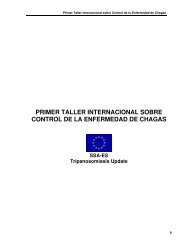El uso de Sistemas de Información Geográfica - CDIA-EC ...
El uso de Sistemas de Información Geográfica - CDIA-EC ...
El uso de Sistemas de Información Geográfica - CDIA-EC ...
Create successful ePaper yourself
Turn your PDF publications into a flip-book with our unique Google optimized e-Paper software.
<strong>El</strong> <strong>uso</strong> <strong>de</strong> <strong>Sistemas</strong> <strong>de</strong> <strong>Información</strong> Geografica y Sensores Remotos (SR) en Salud Pública<br />
Bogotá, Colombia, 27 al 30 <strong>de</strong> Marzo <strong>de</strong> 2006<br />
mejora <strong>de</strong> la vivienda rural y educación primaria en salud, para evitar la<br />
reinfestación <strong>de</strong> las viviendas humanas con triatominos y así reducir la posibilidad<br />
<strong>de</strong> contacto entre hombre y vector (7,8).<br />
En el caso particular <strong>de</strong> T.maculata se <strong>de</strong>muestra la existencia <strong>de</strong> un proceso<br />
activo <strong>de</strong> domiciliación el cual representa un riesgo importante <strong>de</strong> transmisión <strong>de</strong> la<br />
enfermedad en un futuro que <strong>de</strong>be ser monitoreado.<br />
Referencias<br />
1. An<strong>de</strong>rson J.M, Lai J.E., Dotson M, Cordon C, Ponce C, Norris D.E, Beard C.B.<br />
I<strong>de</strong>ntification of microsatellite markers in the Chagas disease vector Triatoma<br />
dimidiata. Infection Genetics and Evolution, 2002; 1: 230-24.<br />
2. Bargues M.D, Guhl F, Mas-Coma S. Genetic characterization of domestic,<br />
peridomestic and sylvatic Triatoma dimidiata populations from Colombia by<br />
ribosomal DNA ITS-2 sequences. Acta Trópica. 2002; 83, S149.<br />
3. Borges E.C, Dujardin J.P, Schofield C.J, Romanha A.J, Diotaiuti L. Dynamics<br />
between sylvatic, peridomestic and domestic populations of Triatoma brasiliensis<br />
(Hemiptera: Reduviidae) in Ceara State, Northeastern Brazil. Acta Trop. 2005;<br />
93(1):119-26<br />
4. Dujardin J.P, Schofield C.J, Panzera F. Los vectores <strong>de</strong> la enfermedad <strong>de</strong><br />
Chagas. Académie Royale <strong>de</strong>s sciences d´Outre-Mer. 2002; 38-39<br />
5. García A.L, Carrasco H.J, Schofield C.J, Valente S.A, Frame I.A, Stothard R,<br />
Miles M.A. Random amplification of polymorphic DNA as a tool for taxonomic<br />
studies of Triatomine bugs (Hemiptera: Reduviidae). J. med. Entomol. 1998; 35:<br />
38-45<br />
6. Gorrochotegui-Escalante N, Muñoz M. L, Fernan<strong>de</strong>z-Salas I, Beaty B. J, Black<br />
W. C IV. Genetic isolation by distance among Ae<strong>de</strong>s aegypti populations along the<br />
northeastern Coast of Mexico. Am. J. Trop. Med. 2000; 62 (2): 200-209.<br />
7. Guhl F, Nicholls S. Manual <strong>de</strong> procedimientos para el diagnóstico <strong>de</strong> la<br />
enfermedad <strong>de</strong> Chagas. Santafé <strong>de</strong> Bogotá. 2001; 11,14,73.<br />
21




